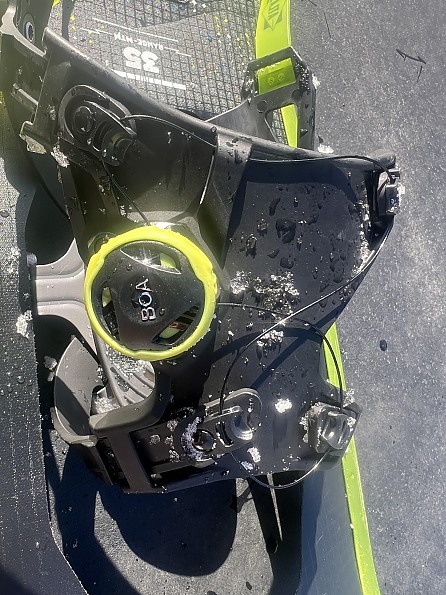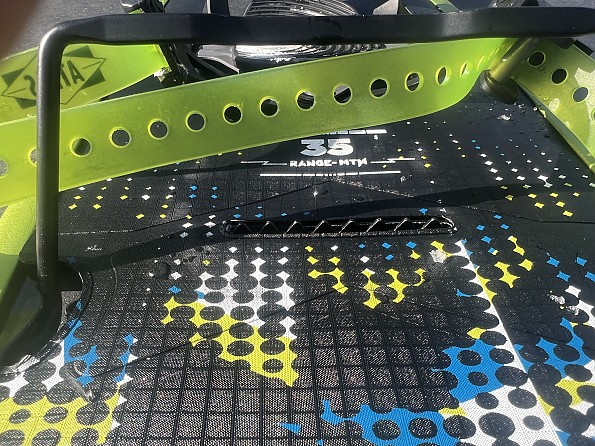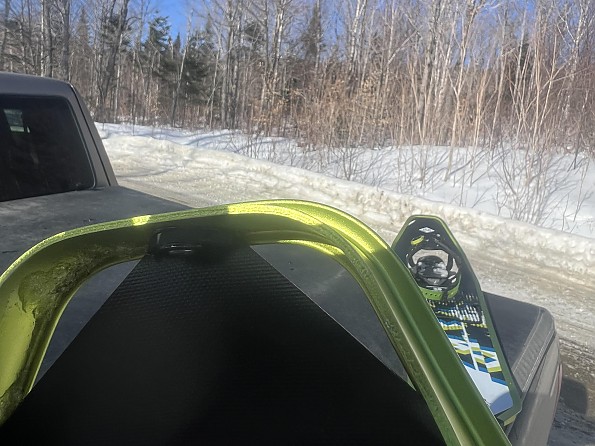Atlas Range MTN 35

The Atlas Range MTN is a traction-framed snowshoe that comes in 25”, 30”, and 35” sizes for men’s snowshoes, and 22” and 26” for women’s. A toothed aluminum perimeter frame and steel toe crampons provide grip in varying snow consistencies. BOA bindings with locking heel straps secure the snowshoes to your feet. Decking is Nytex, a high-temp, high-rigidity, and low moisture-absorptive type of nylon.
Pros
- Traction
- Flotation
- Comfort
- Binding security
Cons
- Price
- Bindings are finicky to tighten
- Tails are sometimes noisy when dragging
Probably 95% of my snowshoeing is done off-trail in the mountains of western Maine, so the traction of mountaineering snowshoes is very nice to have. The problem is that the largest size anyone makes is 8x30, which isn’t large enough for 260lb me and my pack in softer snow. MSR makes tails that add 5 inches to their Lightning series, but I didn’t like those because the rear of the snowshoes rode higher than the front. So I typically used my 10x36 tube-framed backcountry snowshoes for their much better flotation even though their traction wasn’t as good.
Enter the Atlas Range MTN 35. The same overall size as MSR Lightning Ascent 30s with tails, they provide excellent traction without the nose-low attitude and have about 80% of the surface area of 10x36 snowshoes. It’s a very good compromise and I wonder why nobody made a traction-framed snowshoe in that size before. I’ve used them in 18-ish inches of early-season snow at 300-plus pounds (myself and my gear) and was sinking maybe 6”.
The design is pretty typical for this class of snowshoes, a single piece of aluminum is bent and joined at the rear with a plastic connector. There are no welds or rivets holding the frame together.

A BOA binding secures the snowshoe to your foot. There is little to no slop in the connection, your feet will not move in relation to the snowshoe.

The BOA cable pulls the top part of the binding down over 4 straps that are part of the foot plate, and this doesn’t always move smoothly or evenly. I have to help it along most of the time.

The heel strap is self-locking, and also locks in the open position to make loosening the strap easier.

The fixed end of the heel strap simply latches in place with no hardware, making field repairs easier. A ski strap with the same hole spacing and sizing is included, and can be used in place of a broken heel strap.

Steel toe crampons bite and hold in everything from hard packed crust to wetter snowball snow, and to a lesser extent in sugary snow or frozen granules.

A full-width heel lifter is easily raised and lowered with a trekking pole handle or by hand. A short heel rest bar with serrations helps break up packed snow or ice on your heel.

The decking is reinforced in the area of the heel rest to help prevent wear-through.

The frame is T-shaped in cross section, and very rigid. The rear connector is what allows for limited flexibility.

Large, aggressive teeth run down the entire length of the frame rails.

The single crossbar has minimal serrations and helps transfer down force from your heel, or the heel lifter, to the frame.

The decking has a ripstop pattern but it appears to be embossed and not actually woven in. I haven’t had any punctures or tears, though.

The ripstop pattern isn’t evident from the bottom, which makes me think it’s either embossed or an appliqué. Large, thick washers are used to spread out the load where the decking attaches to the frame.

I’ve used the Range MTN 35s for the majority of my snowshoeing this winter and am impressed with them for the most part. The BOA binding allows you to get the tension perfect so there’s no pressure on your feet, and the close hole spacing in the heel strap does the same.
Traction is definitely the Range MTN’s strong point, and only in more granular, frozen snow on steep slopes did I have to herringbone so the frame rails supplied traction. Any other time just jabbing the toe crampons in held me while climbing, even without raising the heel lifter to weight the heel crampons. On descents pointing my toes downward a bit made effective brakes out of the fronts of the toe crampons. Between them and the wide rear crossbar I never felt like my snowshoe would slide when I put my weight on it to step with the other foot.
My complaints are fairly minor, with the worst having to do with the binding. As I mentioned earlier, the top portion of the binding doesn’t pull down evenly and smoothly when tightening the BOA dial, and I have to push down on it at the corners to keep it from catching.
The foot opening is also on the small side, even uninsulated leather hikers have to be wiggled in so they seat fully in the toe stops. Larger insulated boots take quite a bit of wiggling.
The heel strap can sometimes be a pain to unlatch because the locking peg fits tightly, and pulling on the strap to get it off the peg just shuts the latch. Using 2 hands helps but then my knees make all kinds of scary noises from the way I have to bend and twist. I’d also like to see the heel straps pivot at the binding because the straps tend to ride low on my heels. These 3 complaints make the Range MTNs my slowest snowshoes to get into and out of, and are the reason they get 4 stars instead of 5. I wouldn’t mind seeing a strap-style binding, either with pin buckles or ratchets.
The rear of the snowshoes makes a sort of scraping, screeching sound when dragging on firmer, more crusty snow. The frames appear to be cast instead of bent bar stock like the other traction-framed snowshoes I’ve had, and I think that’s the reason because none of my others have ever done it.
Lastly, these are expensive! At $320/pair only MSR Lightning Ascents and Lightning Explores cost more.
All in all the Range MTN 35s have worked very well for me this winter, and I’m glad I bought them even though they’re a little on the expensive side. They’re a fairly niche item - mountain snowshoes for heavier loads or softer snow - but work well enough on rolling terrain and trails that they could easily be the only snowshoes most people need. Every time I see some backpacking YouTuber schlepping 50+ pounds of gear with 22” or 25” MSRs and sinking to his knees or deeper because he chose them for how light they are on his pack instead of how well they do at keeping him on top of the snow I find myself tap-tap-tapping a comment: “Get some Atlas Range MTN 35s!”
Background
One unfortunately very abbreviated winter, with maybe 25-30 total miles on them.
Source: bought it new
Price Paid: $320

